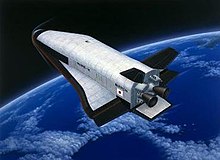HOPE-X
 HOPE-X | |
| Country of origin | Japan |
|---|---|
| Size | |
| Height | 15.2 m (50 ft)[1] |
| Diameter | 9.7 m (32 ft) (wing span)[1] |
| Mass | 14 t (31,000 lb)[1] |
| Stages | launched on H-IIA |
| Launch history | |
| Status | Project cancelled |
HOPE (H-II Orbiting Plane) was a Japanese experimental
History
At the time of the planning phase for HOPE-X, Japanese spaceflight had seen a string of successful advancements in the decade prior, including the development of the
By 1990, NASDA had established the basic concept for the HOPE spaceplane, proposing an unmanned vehicle that would launch atop the in-development H-II rocket, dock with the Space Station Freedom to deliver cargo, and land autonomously on a runway.[3] This evolved into a sub-scale orbital prototype known as HOPE-X, for H-II Orbiting Plane, Experimental. This would be used for flight testing and systems validation, before moving onto the larger HOPE, a 4-man 22-metric-ton (49,000 lb) design. As the name implies, both would be launched on Japan's new H-II launcher, though the full-scale HOPE would require substantial upgrades in launch performance.[4]
Models and test flights
As part of the overall Japanese space program, testing for technologies that would be used on HOPE and other projects was well advanced. In February 1994 the first test flight of the new H-II launcher was used to also launch the experimental OREX ballistic re-entry vehicle, which tested various communications systems, heating profiles and heat shielding components. Another project, HYFLEX, followed in February 1996. Hyflex was intended to test the carbon-carbon heat shielding tiles that were intended to be used on HOPE, as well as having the same body shaping in order to gather data on hypersonic lifting. HYFLEX was successful, but sank in the Pacific after splashdown before it could be recovered. Another test project, ALFLEX followed HYFLEX in 1996.
Reduction in scope
In 1997, well into the study, it was decided that HOPE-X should be modified into an unmanned cargo vehicle with the addition of automated approach and docking systems, and a cargo bay with doors similar to the one on the U.S. Space Shuttle. It was believed this would result in a "quick and dirty" cargo supply system for ISS, which was suffering from continued delays due to problems with the Shuttle program. It was estimated that such a conversion could be completed for an additional
Project conclusion
In 1998, the H-II suffered from a string of failures. A re-evaluation of the entire space program followed, and budget constraints later forced a reduction in overall funding by US$690 million to US$4.22 billion for the five-year spending period between 1998 and 2002. This would force a delay in the timeline for the HOPE-X, with its first flight in 2003. By this time NASDA had spent only US$305 million since the project was approved in 1988, reflecting the status as a research project. The next year the H-II project was cancelled outright, proceeding with the simplified and lighter H-IIA alone.
HOPE continued to soldier on. In 2000, an agreement was signed to land the returning vehicle at Aeon Airstrip on
See also
- Buran (spacecraft)
- Hermesprogram that was a contemporary of HOPE.
- Fuji (Spacecraft)
- H-II Transfer Vehicle
- Space Shuttle program
- RLV-TD- an Indian spaceplane program
- X-37
References
- ^ a b c d "HOPE_X 開発から将来宇宙輸送系に向けて" [HOPE_X Lessons Learned for Future Space Transportation Systems] (PDF). Technical Review (in Japanese). MHI. January 2002. Retrieved 2012-06-06.
- ^ "Japan's Space Program". Nippon.com. Retrieved 28 March 2024.
- )
- doi:10.1063/1.54897.
- ^ "High Speed Flight Demonstration "HSFD"". Technical Review. JAXA. July 2003. Retrieved 2014-06-10.
- ^ Jos Heyman, "Spaceplanes That Never Were...," MilSat Magazine, Sept. 2016. Retrieved 2022-02-03.
